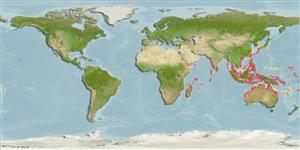Common names from other countries
Environment: milieu / climate zone / depth range / distribution range
Ecologia
; intervalo de profundidade 1 - 15 m (Ref. 348). Tropical
Indo-Pacific: from East Africa, to Melanesia; north to Japan and south to Queensland.
Length at first maturity / Tamanho / Peso / Idade
Maturity: Lm ? range ? - ? cm
Byssally attached to hard objects, on reef flats, coarse coral sand or eelgrass areas. The shell is vertically disposed and partly buried in sediment, with the long dorsal ears acting as an anchor and the ventral quarter of valves exposed. Sublittoral. Often occurring in large colonies (Ref. 348).
Life cycle and mating behavior
Maturidade | Reprodução | Desova | Ovos | Fecundidade | Larvas
Members of the class Bivalvia are mostly gonochoric, some are protandric hermaphrodites. Life cycle: Embryos develop into free-swimming trocophore larvae, succeeded by the bivalve veliger, resembling a miniature clam.
Poutiers, J.M. 1998. (Ref. 348)
Categoria na Lista Vermelha da IUCN (Ref. 130435)
Categoria CITES (Ref. 108899)
Not Evaluated
Not Evaluated
Ameaça para o homem
Harmless
Utilização humana
| FishSource |
Ferramentas
Mais informação
Idade/TamanhoCrescimentoComprimento-pesoComprimento-comprimentoMorfologiaLarvasAbundância
Fontes da internet
Estimates based on models
Preferred temperature
(Ref.
115969): 24.7 - 29.3, mean 28.5 (based on 3422 cells).
Categoria de preço
Unknown.
